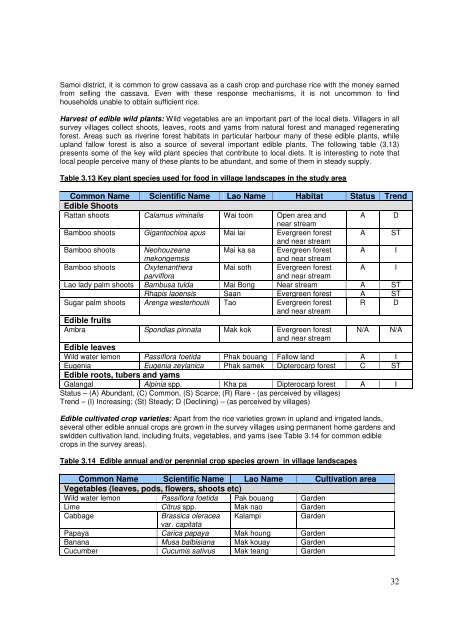Part 1 – A Rapid Participatory Biodiversity Assessment - IUCN
Part 1 – A Rapid Participatory Biodiversity Assessment - IUCN
Part 1 – A Rapid Participatory Biodiversity Assessment - IUCN
Create successful ePaper yourself
Turn your PDF publications into a flip-book with our unique Google optimized e-Paper software.
Samoi district, it is common to grow cassava as a cash crop and purchase rice with the money earned<br />
from selling the cassava. Even with these response mechanisms, it is not uncommon to find<br />
households unable to obtain sufficient rice.<br />
Harvest of edible wild plants: Wild vegetables are an important part of the local diets. Villagers in all<br />
survey villages collect shoots, leaves, roots and yams from natural forest and managed regenerating<br />
forest. Areas such as riverine forest habitats in particular harbour many of these edible plants, while<br />
upland fallow forest is also a source of several important edible plants. The following table (3.13)<br />
presents some of the key wild plant species that contribute to local diets. It is interesting to note that<br />
local people perceive many of these plants to be abundant, and some of them in steady supply.<br />
Table 3.13 Key plant species used for food in village landscapes in the study area<br />
Common Name<br />
Edible Shoots<br />
Scientific Name Lao Name Habitat Status Trend<br />
Rattan shoots Calamus viminalis Wai toon Open area and<br />
near stream<br />
A D<br />
Bamboo shoots Gigantochloa apus Mai lai Evergreen forest<br />
and near stream<br />
A ST<br />
Bamboo shoots Neohouzeana Mai ka sa Evergreen forest A I<br />
mekongemsis<br />
and near stream<br />
Bamboo shoots Oxytenanthera Mai soth Evergreen forest A I<br />
parviflora<br />
and near stream<br />
Lao lady palm shoots Bambusa tulda Mai Bong Near stream A ST<br />
Rhapis laoensis Saan Evergreen forest A ST<br />
Sugar palm shoots<br />
Edible fruits<br />
Arenga westerhoutii Tao Evergreen forest<br />
and near stream<br />
R D<br />
Ambra<br />
Edible leaves<br />
Spondias pinnata Mak kok Evergreen forest<br />
and near stream<br />
N/A N/A<br />
Wild water lemon Passiflora foetida Phak bouang Fallow land A I<br />
Eugenia Eugenia zeylanica Phak samek Dipterocarp forest C ST<br />
Edible roots, tubers and yams<br />
Galangal Alpinia spp. Kha pa Dipterocarp forest A I<br />
Status <strong>–</strong> (A) Abundant, (C) Common, (S) Scarce; (R) Rare - (as perceived by villages)<br />
Trend <strong>–</strong> (I) Increasing; (St) Steady; D (Declining) <strong>–</strong> (as perceived by villages)<br />
Edible cultivated crop varieties: Apart from the rice varieties grown in upland and irrigated lands,<br />
several other edible annual crops are grown in the survey villages using permanent home gardens and<br />
swidden cultivation land, including fruits, vegetables, and yams (see Table 3.14 for common edible<br />
crops in the survey areas).<br />
Table 3.14 Edible annual and/or perennial crop species grown in village landscapes<br />
Common Name Scientific Name Lao Name Cultivation area<br />
Vegetables (leaves, pods, flowers, shoots etc)<br />
Wild water lemon Passiflora foetida Pak bouang Garden<br />
Lime Citrus spp. Mak nao Garden<br />
Cabbage Brassica oleracea Kalampi Garden<br />
var. capitata<br />
Papaya Carica papaya Mak houng Garden<br />
Banana Musa balbisiana Mak kouay Garden<br />
Cucumber Cucumis sativus Mak teang Garden<br />
32

















